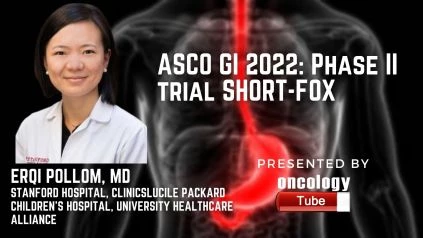Erqi Pollom, MD, Assistant Professor of Radiation Oncology and, by courtesy, of Neurosurgery at Stanford Hospital and Clinics, Lucile Packard Children’s Hospital, and University HealthCare Alliance. In this video she speaks about the ASCO GI 2022 Abstract – Phase II trial of organ preservation program using short-course radiation and folfoxiri for rectal cancer (SHORT-FOX). This study was conducted along with George A. Fisher Jr., MD, Daniel Chang, MD, Andy Johnson, MD, and others.
Brief history:
Preoperative chemoradiotherapy and total mesorectal excision are used to treat locally advanced rectal cancer (TME). While this trimodal method results in modest local recurrence rates, distant metastatic rates can reach 25%. In the OPRA, RAPIDO, and PRODIGE23 trials, total neoadjuvant therapy (TNT) was demonstrated to minimize the risk of distant metastasis and improve rates of pathological complete response when compared to normal preoperative chemoradiotherapy. As a result, TNT not only tackles distant disease but also provides the opportunity to reduce locoregional morbidity by preserving organs. We suggest a therapeutic strategy that combines TNT with FOLFOXIRI, as well as up-front short-course radiation, with the goal of enhancing clinical complete response (cCR) rates and, as a result, organ preservation eligibility. Currently, a multidisciplinary team using flexible endoscopy and MRI can effectively assess clinical response following neoadjuvant therapy. The study of circulating tumor DNA (ctDNA) can be used to monitor tumors in a non-invasive way. Biomarker discovery is critical for better selecting patients for treatment de-escalation and monitoring for recurrence so that the remarkable cure rates achieved with a standard of care therapy are not jeopardized.
Methodologies:
For patients with > T2N0 or low T2N0, M0 rectal cancer, this is a single-arm, open-label, non-randomized research of an organ preservation approach using short-course radiation followed with FOLFOXIRI (NCT04380337). Patients receive 25 Gy/5 fractions of radiation plus a 5 Gy/1 fraction boost, followed by 8 cycles of FOLFOXIRI. At 8 weeks after finishing chemotherapy, patients are evaluated for response using pelvic MRI (MRI Tumor Regression Grading), flexible sigmoidoscopy, and a digital rectal exam. Those who attain a cCR can postpone TME and are monitored. The primary goal is to evaluate cCR, with the expectation that this approach will result in greater cCR rates than previous controls (40 versus 20 percent ). Toxicity, local regrowth rate, disease-free survival, colostomy-free survival, overall survival, and longitudinal health-related quality of life are all secondary goals. ctDNA will be collected throughout therapy and surveillance, and studies will be conducted to see if there is a link between ctDNA levels and cCR, local regrowth, or disease-free survival. Our primary goal was met with a Simon 2-stage design. We propose to enroll 37 patients, assuming a one-sided type 1 error of 0.1, power of 0.9, and a null cCR of 0.2 vs an alternate cCR of 0.4. If more than 11 patients have cCR, the null hypothesis will be rejected. The experiment has enrolled seventeen individuals and is now on hold for a scheduled interim review for futility and safety. The trial will be terminated if at least three individuals develop cCR or if at least seven patients develop non-hematologic grade 4+ toxicity. Otherwise, we’ll continue to take on another 20 patients. NCT04380337 is the number for the clinical trial.

